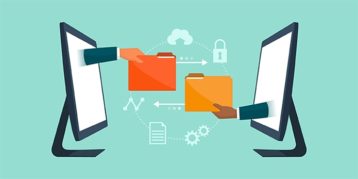Due to the increasing use of artificial intelligence and machine learning, data is also increasing in value. However, such technologies require vast amounts of data. While a lot of data is available for free, the information is often inconsistent, unstructured and limited in quality. The truly useful data is held in corporations and kept from public access.

Data sharing provides the ability to achieve the following benefits.
- Unlock valuable data assets.
- Increase employee collaboration and productivity.
- Reduce unnecessary efforts and expenditures.
- Increase stakeholder transparency and trust.
- Allow for more efficient use of resources across the enterprise.
Table of Contents
1. Unlock Valuable Data Assets

Data has limitless potential value, which is why businesses are always looking for ways to unlock the insights hidden in the data. Many companies go about this differently, but collaboration (data sharing) is the easiest way.
If employees worked on a set of data individually, the insights would vary from one individual to another. However, by collaborating on the data set, the data will be able to provide more insights since the group effort is more than the individual. The insights from the data will be more valuable and push the company further.
Note:
As long as the organization has a solid data governance program to avoid degrading the data’s quality, data sharing will be the most effective way to get the most out of an organization’s big data.2. Increase Employee Collaboration and Productivity
Organizations typically have vast datasets, but not all are deployed at once. Most are data at rest, meaning data that is not currently active or traveling from network to network or device to device and is stored in a platform. The answers to business issues that most employees are looking for can often be found in the data. Still, due to security concerns, employees cannot gain access to the datasets, which causes delays.

On the other hand, organizations can provide a faster means of exchanging data while maintaining security and delivering organized workflows to employees, leading to better comprehension by utilizing data sharing technologies.
3. Reduce Unnecessary Efforts and Expenditures

By sharing data across companies, manufacturers can reduce unnecessary efforts and expenditures in the value chain. A lot of managers use data sharing to reduce costs and improve operations.
A recent study showed a strong positive correlation between data sharing and lower hospital costs. Further analysis revealed that hospitals in poorer, less concentrated places saved more than those in more-concentrated, wealthier areas. However, the effect of data sharing remains the same regardless of wealth or concentration.
4. Increase Stakeholder Transparency and Trust

Data sharing gives stakeholders a unified view and access to a single data source. Companies can build a culture of transparency and openness among departments, teams and other businesses. This is possible because everyone has access to the same data pool, meaning everyone can trust the data and carry out any task securely with the dataset.
5. Allow for More Efficient Use of Resources across the Enterprise

Most benefits of data sharing are economical. Businesses can share data to solve a problem that may cost too much to solve in-house, especially if lacking the necessary skills. Data sharing helps companies generate ideas or learn new ways to process data. Data sharing also saves businesses time and money by bringing several teams/disciplines together to improve existing products and services, and build new ones.
How does Data Sharing Work?
Companies often develop in-house data sharing policies that also depend on the type of data sharing technology being used. However, the general data sharing process involves securing the dataset through encryption, transferring the data to authorized employees, and analyzing and producing results from the dataset.

To understand how data sharing works, consider this sequence: The first step is to encrypt the data, meaning unauthorized users cannot decode the original information. Next is to add some noise to the dataset, after which the dataset will be impossible to reverse-engineer to the initial inputs.
A key is shared to select users, giving access to some parts of the encrypted data. Each user can analyze aspects of the data and share insights from the analysis without sharing the actual data file.
What is the Importance of Data Sharing?
Data sharing is important because companies can have all the relevant content in one place for the teams or businesses involved.

But what is data sharing? Data sharing is a communication practice allowing companies to access a more extensive data pool, bringing more valuable insights and informing future decisions. Data sharing is used in skill development, increasing legal compliance and improving an organization’s data structure. Further, this method fosters relationships and collaborations that impact the standard of each organization’s output and public perception.
For example, in the health care industry, sharing data can lead to fewer hospital and emergency room admissions and doctor visits. Sharing medical and health data helps reduce medication errors and the likelihood of redundant testing.
What are the Disadvantages of Data Sharing?
The disadvantages of data sharing include a higher risk of files getting infected or leaked, plagiarism issues and network speeds.

There is a higher risk of viruses, ransomware and malware infecting shared data. The malware could be on the workstation the file was transferred to. Once the file is uploaded back to the organization’s network, the malware tags along for a ride.
There’s also the increased chance of data breaches and leaks. When data is being shared, hackers or careless employees could leak the data to the public.
Pro Tip:
High network speeds are required to access files and share data easily. If an employee has a slow network, the sharing process can be tedious.Also, data sharing could bring potential issues with plagiarism and data theft. An employee may take the ideas or thoughts of another employee and try to sell the concept or pretend to come up with the idea. Catching such acts as proprietary theft can be a challenge unless the firm has a data sharing and piracy monitoring program.
Is there a Data Sharing Policy?
What is a data sharing policy? This refers to the rules and regulations put in place to govern data sharing. Although a data sharing policy exists, the policy doesn’t apply generally. Different locations and industries usually have different ways of handling data sharing.

Several data protection laws—such as the General Data Protection Regulation, the Health Insurance Portability and Accountability Act, the California Consumer Privacy Act and the Payment Card Industry Data Security Standard—exist to protect consumers from companies that carelessly share data with third parties.
Companies usually set up an internal data sharing agreement between two or more organizational units. The contract usually contains the description of the data, the source, the destination and the method of sharing.

